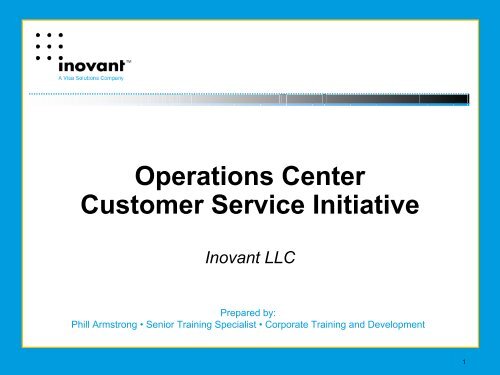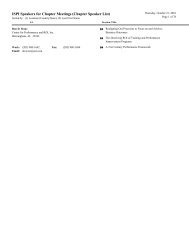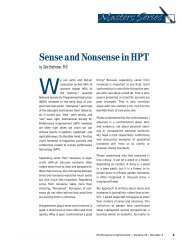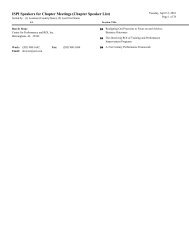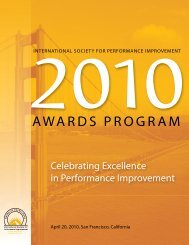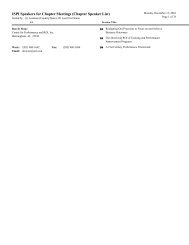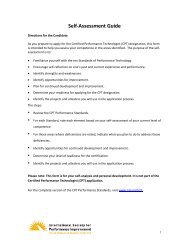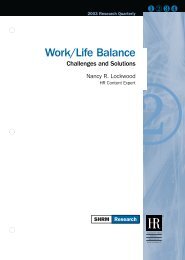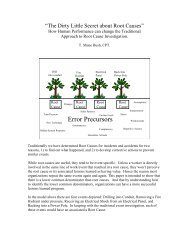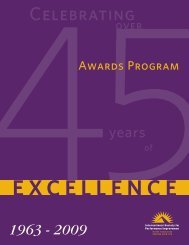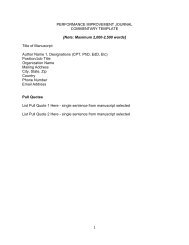Operations Center Customer Service Initiative
Operations Center Customer Service Initiative
Operations Center Customer Service Initiative
Create successful ePaper yourself
Turn your PDF publications into a flip-book with our unique Google optimized e-Paper software.
<strong>Operations</strong> <strong>Center</strong><br />
<strong>Customer</strong> <strong>Service</strong> <strong>Initiative</strong><br />
Inovant LLC<br />
Prepared by:<br />
Phill Armstrong • Senior Training Specialist • Corporate Training and Development<br />
1
Business Need<br />
Background<br />
• As the custodian of the world’s largest payment transaction engine, Inovant’s technical<br />
operations teams process 100 million+ payment transactions a day representing $1.4 trillion<br />
annually. In just one hour, Inovant is capable of processing more transactions than all the<br />
stock exchanges in the world handle in one day – with nearly 100% reliability.<br />
Inovant’s technical operations teams are the frontline support for banks around the world who<br />
connect with Visa to process payment transactions. Every day, Visa’s member banks place<br />
their trust directly in the hands of these technical experts.<br />
Business problem<br />
• In 2002 all customer satisfaction service levels were met and customer satisfaction scores<br />
were satisfactory. Nonetheless, there was a strong theme and sense of urgency that these<br />
teams could improve customer satisfaction.<br />
The challenge<br />
• How can we raise our customer’s satisfaction while maintaining our high<br />
availability and technical service level agreements?<br />
• How can we position our operations teams to continue to improve customer<br />
satisfaction results?<br />
2
Intervention<br />
Needs Analysis suggested:<br />
• Performance objective collaboration – Communication plan created and presented in<br />
order to share the customer satisfaction survey and its results. Facilitated sessions were<br />
held where technical operations teams developed performance objectives that specifically<br />
addressed survey metrics. Themes: expectation setting, feedback, ownership, social<br />
contracting (fully implemented)<br />
• <strong>Customer</strong> <strong>Service</strong> Skills Training – Several operations teams exhibited a lack of<br />
fundamental customer service skills. A call flow process was documented and integrated<br />
into training. Training was customized to include telephone customer service role play<br />
scenarios that reflected specific examples from the technical operations team’s<br />
environment. Themes: new process and skills transfer, practical application, re-usable call<br />
flow process model, skills underpinned team performance objectives (fully implemented)<br />
• Manager coaching and reinforcement plan – Coaching sessions with operations team<br />
managers offered tools and methods for implementing real-time objective based<br />
performance feedback, call review model, fun reinforcement games and “energizer”<br />
exercises. Themes: motivation and incentives (rewards and consequences), feedback,<br />
communication, accountability (25% implemented – full implementation in progress)<br />
• Equipment upgrades – Automated Call Distribution (ACD) infrastructure was poorly<br />
implemented and/or utilized. Use of telecom headsets, call review, integration<br />
into individual performance plan and review system recommended.<br />
Themes: supportive work environment, feedback, team and individual<br />
accountability (10% implemented – full implementation in progress)<br />
3
Results<br />
• Highly Satisfied customers<br />
8.6%<br />
• Very Highly Satisfied<br />
customers 6.8%<br />
60%<br />
50%<br />
40%<br />
30%<br />
197<br />
—<br />
390<br />
2<br />
145<br />
—<br />
376<br />
2<br />
127<br />
—<br />
390<br />
2<br />
154<br />
—<br />
376<br />
2<br />
2002<br />
2003<br />
2<br />
• Very Low and Low<br />
customers 3.1%<br />
20%<br />
10%<br />
2<br />
29<br />
—<br />
390 16<br />
—<br />
376<br />
2<br />
37<br />
—<br />
390<br />
2<br />
61<br />
—<br />
376<br />
• Satisfied customers 11.3%<br />
0%<br />
Very Low &<br />
Low<br />
Satisfaction<br />
Satisfied<br />
High<br />
Satisfaction<br />
Very High<br />
Satisfaction<br />
14% 1 of respondents moved from low and satisfied<br />
states to being either high or very highly satisfied<br />
1 Numeric variation is due to “not applicable” survey responses<br />
2 Numerator = Category responses (i.e. satisfied, highly satisfied, etc.) / Denominator = Total survey question responses<br />
4
Lessons Learned<br />
• Metrics matter! Isolating the meaning of Likert<br />
scaled based surveys, rather than simply<br />
averaging scores (thereby also averaging the<br />
meaning) offers more meaning/useful reporting<br />
and feedback metrics.<br />
• Training intervention is only a piece of the<br />
performance solution<br />
• Integration of feedback and accountabilities is key<br />
to improved customer satisfaction<br />
5
CY 2004 Objective<br />
• <strong>Customer</strong> satisfaction score target: Ideal average<br />
of customer satisfaction = Highly Satisfied<br />
SCORE “4”<br />
Implement regular reporting and feedback<br />
Implement team and individual accountabilities and<br />
incentives<br />
Implement improved equipment use practices<br />
Continue to support skill gaps with training, learning<br />
opportunities, and/or coaching<br />
6


